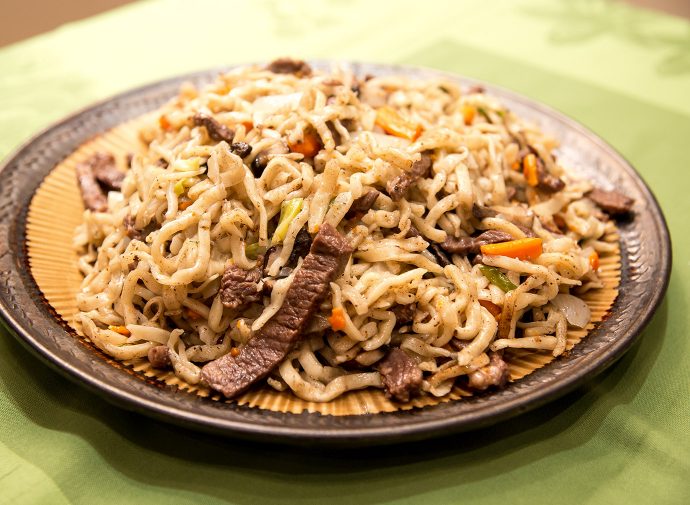Ingredients
1 pound home made noodles or
1 pound Wang brand Vermicelle
3 cups vegetables like white cabbage and carrot, cut in ¼ inch julienne
1 medium size onion, cut into half moon slices
1 lb beef, cut against the grain into ¼ inch strips, flank steak or skirt steak recommended
2 cloves garlic, minced
¼ cup vegetable oil
soy sauce (optional)
Instructions
Sauté the vegetables, onion and garlic together until they are crisp-tender. Add the beef and stir-fry just until it looses its raw color. Season with salt and pepper and set aside.
In a non-stick pan, heat the remaining 2 tbl of oil and toss in the noodles to coat with the hot oil, add a quarter cup of water, cover the pan and let them steam for a few minutes until the water evaporates and they are almost tender. Add the vegetables and meat back into the pan, add a bit more water, cover and stir-fry together. Taste again for salt and pepper and serve. Because Mongolian food is greatly impacted by China, this dish is often seasoned with soy sauce rather than salt.


Dear Lisa,
i just featured your Tsuivan recipe on my Trans Mongolian Food Guide Post 🙂 I am really amazed by your website and very happy that I discovered it on the web.
Sending you all the best wishes from the Road
Michael from Foodvagabonds
Thanks so much for featuring this recipe and my website! It is wonderful to be introduced to your website as well. Best regards, Lisa
Our field cook- Ner Gui, makes this pretty regularly. My Colleague at U Edinburgh makes the observation that there are three stages of Tsuivan- 1} Awesome!! We get Tsuivan for lunch again!! 2) Wow. There’s a *Lot* of Tsuivan. 3) Uuuuuurrrrrrk….
That said, it’s a wonderful dish. It would be good (and proper) to go ahead and include the noodle making part, because that is a big part of the cooks day who makes this. Also mention that beef works for the American palette, but generally Mongols will use a caprid of some sort- sheep or goat as beef may not always be available and most people in the countryside herd sheep and goats anyway. Glad to see at least a recipe.
Thanks so much for sharing this story about Tsuivan. Where were you and what were you researching when Ner Gui cooked for you? Lisa